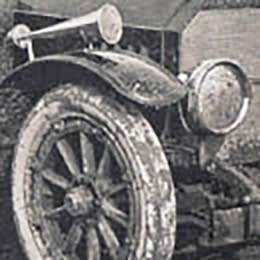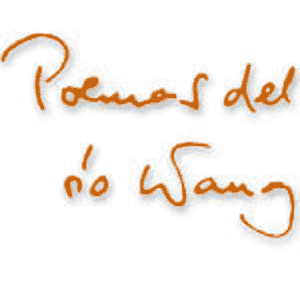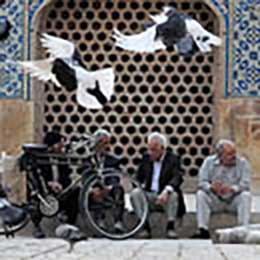After the sad story of the Armenian cemetery of Julfa, let us now see a merry cemetery.

 Here I lie. My name is Stan Ion Mihăieş and I was a policeman. From here I went to Braşov where I was a good policeman. And now I give a salute to you because we will not see each other any more. I said farewell to the world at the age of 58, and reposed in the year of 1952.
Here I lie. My name is Stan Ion Mihăieş and I was a policeman. From here I went to Braşov where I was a good policeman. And now I give a salute to you because we will not see each other any more. I said farewell to the world at the age of 58, and reposed in the year of 1952.

The merry cemetery – this is also how it is “officialy” called: Cimitirul Vesel – is in the village of Săpânţa of Maramureş county at the Ukrainian-Romanian border, only some eighty kilometers from the Hungarian border. Its establishment was the merit of the local wood carver Stan Ioan Patraş who since around 1935 has become with his popular rhymed epitaphs and colored death images the specialist of wooden crosses in the village. These crosses attest the same breathtaking creativity of Romanians as among others the village churches and wooden houses painted both in- and outside all over Transylvania.
 Here I lie. I was called Stan Anuţa, but in my childhood my name was Prilogan. Since I have married Vasil, we have lived well, everybody saw it in the village. I maintained a beautiful household, I was a believer, on the feast of Epiphany I served to the priest at our table during the benediction of our house. I do not serve any more, because I have moved here, under the shadow of the church.
Here I lie. I was called Stan Anuţa, but in my childhood my name was Prilogan. Since I have married Vasil, we have lived well, everybody saw it in the village. I maintained a beautiful household, I was a believer, on the feast of Epiphany I served to the priest at our table during the benediction of our house. I do not serve any more, because I have moved here, under the shadow of the church.
 I am Dioca Ţăhu, here I lie in the shadow of the plum tree. If you stop here, you will get to know that I was a column of my house which I have left crying and mourning. Since my childhood I loved to work, I loved very much to take care of the horse and sheep. None else in the village had such horses and sheep like me. I loved very much the horses, and they were also the reason of my death. For while sitting on the haystack on my coach, I fell down and this is how I found my death.
I am Dioca Ţăhu, here I lie in the shadow of the plum tree. If you stop here, you will get to know that I was a column of my house which I have left crying and mourning. Since my childhood I loved to work, I loved very much to take care of the horse and sheep. None else in the village had such horses and sheep like me. I loved very much the horses, and they were also the reason of my death. For while sitting on the haystack on my coach, I fell down and this is how I found my death.
The verses and the images represent the life of the deceased as compressed into one definitive moment, in a fixed posture, like on the peasants’ photos: in the way as they wanted to see themselves and have themselves seen, indicating that they suited the norms of the community.

In a very few case the grave-post presents the deceased without any idealization. Who was it to permit to (or even pay for) having his or her kin immortalized in this way? One thing is certain that this cross will be a memento against drinking for the whole community in his death just like his person was in his life.


And here is the inn-keeper too, who was his ruin. True, he apologizes of having always cautiously retailed alcohol: “to whoever it went quickly to the head, I only gave a half shooter, but to the sober ones I gave with full glass”.

In other cases it is the reason of the death that they represent, when it was exceptional and tragic and thus memorable for all.



And here is the master himself, “the creator of the Merry Cemetery”. Here he was already modeled by his successor, but in the following image which hangs on the wall of the nearby Stan Ioan Patraş memorial house next to the carved tableau of Nicolae Ceauşescu with the Executive Committee of the Romanian Communist Party and the plate painted with the arms of the Communist Romania, he himself immortalized the moment when in 1935 he began to carve the first cross.
 And by now even the cross of the master’s successor – who is here painting the cross of the master – has been painted by his successor.
And by now even the cross of the master’s successor – who is here painting the cross of the master – has been painted by his successor.
My one-time master, the death and cemetery researcher, psychologist, painter and visual anthropologist Ernő Kunt, as he did in those times when after a long day of fieldwork we sat down at the discussion table, would also ask me now: what do you think about it? And I would say something like as in a traditional peasant community every important occurrence in the life of an individual from birth through wedding to death and to mourning is a public event, thus these grave-posts also speak to the community, reinforcing its norms and defining the place of the individual in it, much more than in our culture where death and grave are part of the personal sphere. I would also say that probably it was some local master in other cemeteries too who established a local style of crosses and headstones, and this is why every cemetery has its own style and face. He would smile with satisfaction, I don’t know whether for my reply or for what he is going to say, and would begin to expose his opinion. And I would listen attentively, for by now he knows already much more about death than anyone else.

 Here I lie. My name is Stan Ion Mihăieş and I was a policeman. From here I went to Braşov where I was a good policeman. And now I give a salute to you because we will not see each other any more. I said farewell to the world at the age of 58, and reposed in the year of 1952.
Here I lie. My name is Stan Ion Mihăieş and I was a policeman. From here I went to Braşov where I was a good policeman. And now I give a salute to you because we will not see each other any more. I said farewell to the world at the age of 58, and reposed in the year of 1952.
View Río Wang in a larger map |
 Here I lie. I was called Stan Anuţa, but in my childhood my name was Prilogan. Since I have married Vasil, we have lived well, everybody saw it in the village. I maintained a beautiful household, I was a believer, on the feast of Epiphany I served to the priest at our table during the benediction of our house. I do not serve any more, because I have moved here, under the shadow of the church.
Here I lie. I was called Stan Anuţa, but in my childhood my name was Prilogan. Since I have married Vasil, we have lived well, everybody saw it in the village. I maintained a beautiful household, I was a believer, on the feast of Epiphany I served to the priest at our table during the benediction of our house. I do not serve any more, because I have moved here, under the shadow of the church. I am Dioca Ţăhu, here I lie in the shadow of the plum tree. If you stop here, you will get to know that I was a column of my house which I have left crying and mourning. Since my childhood I loved to work, I loved very much to take care of the horse and sheep. None else in the village had such horses and sheep like me. I loved very much the horses, and they were also the reason of my death. For while sitting on the haystack on my coach, I fell down and this is how I found my death.
I am Dioca Ţăhu, here I lie in the shadow of the plum tree. If you stop here, you will get to know that I was a column of my house which I have left crying and mourning. Since my childhood I loved to work, I loved very much to take care of the horse and sheep. None else in the village had such horses and sheep like me. I loved very much the horses, and they were also the reason of my death. For while sitting on the haystack on my coach, I fell down and this is how I found my death.The verses and the images represent the life of the deceased as compressed into one definitive moment, in a fixed posture, like on the peasants’ photos: in the way as they wanted to see themselves and have themselves seen, indicating that they suited the norms of the community.

In a very few case the grave-post presents the deceased without any idealization. Who was it to permit to (or even pay for) having his or her kin immortalized in this way? One thing is certain that this cross will be a memento against drinking for the whole community in his death just like his person was in his life.


And here is the inn-keeper too, who was his ruin. True, he apologizes of having always cautiously retailed alcohol: “to whoever it went quickly to the head, I only gave a half shooter, but to the sober ones I gave with full glass”.

In other cases it is the reason of the death that they represent, when it was exceptional and tragic and thus memorable for all.



And here is the master himself, “the creator of the Merry Cemetery”. Here he was already modeled by his successor, but in the following image which hangs on the wall of the nearby Stan Ioan Patraş memorial house next to the carved tableau of Nicolae Ceauşescu with the Executive Committee of the Romanian Communist Party and the plate painted with the arms of the Communist Romania, he himself immortalized the moment when in 1935 he began to carve the first cross.
 And by now even the cross of the master’s successor – who is here painting the cross of the master – has been painted by his successor.
And by now even the cross of the master’s successor – who is here painting the cross of the master – has been painted by his successor.My one-time master, the death and cemetery researcher, psychologist, painter and visual anthropologist Ernő Kunt, as he did in those times when after a long day of fieldwork we sat down at the discussion table, would also ask me now: what do you think about it? And I would say something like as in a traditional peasant community every important occurrence in the life of an individual from birth through wedding to death and to mourning is a public event, thus these grave-posts also speak to the community, reinforcing its norms and defining the place of the individual in it, much more than in our culture where death and grave are part of the personal sphere. I would also say that probably it was some local master in other cemeteries too who established a local style of crosses and headstones, and this is why every cemetery has its own style and face. He would smile with satisfaction, I don’t know whether for my reply or for what he is going to say, and would begin to expose his opinion. And I would listen attentively, for by now he knows already much more about death than anyone else.



























































































Add comment